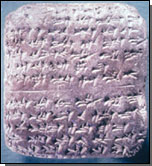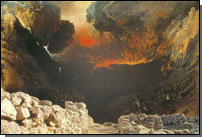 |
 |
---------
History
---------
|
|
 |
History of Megiddo
Megiddo is widely regarded as the most important biblical period site in Israel. Surrounded by
mighty fortifications, outfitted with sophisticated water installations, and adorned with
impressive palaces and temples, Megiddo was the queen of cities of Canaan and Israel.
Megiddo began to dominate the surrounding countryside in the 4th millennium B.C.E. (ca.
3500) — at the dawn of urbanization in the Levant. Today its monumental architecture provides
the most impressive evidence of the rise of the first cities in the region.

El-Amarna Tablet 365, sent from Megiddo. |
 |
15th century B.C.E., conquered
Canaan; it was from here that Assyria staged its deportation of the people of the Northern Kingdom of Israel;
and it was here that Josiah—the last righteous king of the lineage of David—was killed by Pharaoh Necho II,
opening the way for centuries of messianic yearning.
In the late 4th, 3rd and 2nd millennia B.C.E. Megiddo was probably the most powerful
city-state in the north of Canaan. When the Canaanite city-states revolted against Pharaonic
attempts at hegemony, it was at Megiddo that they assembled to do battle. The Egyptian army,
led by Pharaoh Thutmose III, surprised the rebels by choosing the most dangerous route of
attack — through the narrow 'Aruna Pass. After routing the Canaanite forces and capturing rich
booty, Thutmose III laid siege to the city for seven months. His decisive victory enabled him to
incorporate Canaan as
|
a province in the empire of the New Kingdom. The description of the battle of Megiddo is the earliest
account of a major war in antiquity.
Six letters sent by Biridiya, King of Megiddo, to the Egyptian Pharaoh Akhenaten in the 14th century
B.C.E. were discovered in the archive of el-Amarna in Egypt. The letters indicate that Megiddo was
one of the mightiest city-states in Canaan. The magnificent ivories found in the Late Bronze Age
palace at the site also attest to the city's wealth and grandeur and its varied cultural contacts in
this era.
The Bible lists the king of Megiddo among the Canaanite rulers defeated by Joshua in his conquest
of the land (Josh. 12:21). According to I Kings (9:15), King Solomon built Megiddo together with
Hazor and Gezer. At that time the city had become the center of a royal province of the United
Monarchy. The Egyptian Pharaoh Shishak took Megiddo in the second half of the 10th century. His
conquest of the city is affirmed both in his inscriptions at the Temple at Karnak and in a stele
erected at the site. In the 9th and 8th centuries B.C.E., the rulers of the Northern Kingdom refitted
the fortress even more elaborately than before. The palaces, water systems and fortifications of
Israelite Megiddo are among the most elaborate Iron Age architectural remains unearthed in the
Levant.
|
 |

The Shoshenq I (Shishak) inscription at Karnak, Upper Egypt. |

Megiddo remains on the background of John Martin's painting of Armageddon. |
 |
In 732 B.C.E., the Assyrian King Tiglath-pileser III took the region from the Northern Kingdom. In the
following years Megiddo served as the capital of an Assyrian province. With the fall of the Assyrian
empire the great religious reformer, King Josiah of Judah, was called to Megiddo to report to Pharaoh
Necho of Egypt, who was on his way to assist the crumbling Assyrian army in its last-ditch efforts
against the Babylonians. Josiah was slaughtered by Necho (II Kings 23:29). Recollection of this event,
along with the memories of the great battles fought here, were probably the bases for the idea in the
Book of Revelations (16:16) that Armageddon (the mound of Megiddo) would at the end of days be
the site of the last battle between the forces of good and the forces of evil.
|
|
In the modern era Megiddo has also played a decisive role in battles for the control over the Jezreel
Valley. In World War I, British Field Marshal Edmund Allenby, leading an Australian cavalry division and
the Tenth Indian infantry, dislodged from the advantageous heights of the mound a group of about
100 Turkish fighters defending the last vestiges of the Ottoman Empire. Allenby used tactics similar
to those of Thutmose III (over 3000 years earlier), by cutting through the 'Aruna Pass and catching
the Turks unaware. The historical significance of the site prompted Allenby to include the name of
Megiddo in his family's hereditary title.
|
 |

Fieldmarshal Edmund Allenby, Lloyd George and King Faysal in London, 1919. |

Pope Paul VI and Israel's President Shazar at Megiddo, 1964. |
 |
Because of Megiddo's great significance for both Christians and Jews, the site was chosen as the
historic meeting place for the 1964 visit of Pope Paul VI with Israel's president, Zalman Shazar, and
prime minister, Levi Eshkol. It was the first visit ever of a pope to the Holy Land.
|
|
|
 |
 |
 |





